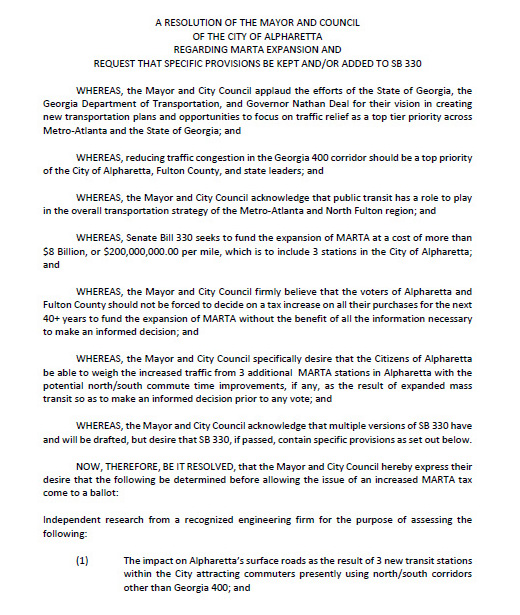In an earlier post I wrote about my experience at the state capital last week. For more background you should also read this article about the hearing at GeorgiaPol.com.
As I testified at the senate hearing Senator Beach commented, “We can disagree without being disagreeable” and I couldn’t agree more. That is why some of the comments made by him and others supporting his 50% MARTA tax increase are so troublesome.
That doesn’t make sense to Beach. MARTA’s opponents, he said, are desperate for solutions. “Some of the politicians are saying, well, nobody is going to use it, and then in the next sentence they’re saying it’s going to create so much congestion coming into it. Well, you can’t have it both ways. If you’re going to have all this congestion, you’re going to have ridership. Just tell me one or the other.”
“The politicians are scared to death” of MARTA expansion, Beach said in an interview earlier this week.
What a perfect example of heavy rail supporters insulting their opponents and misleading the public without addressing the facts laid out by their opposition. Senator Beach’s assertion that politicians say, “nobody is going to use it” is just false hyperbole.
I have never heard it said by any opponent of heavy rail. However I have repeatedly pointed out that the U.S. Census shows only 2% of Fulton County residents ride heavy rail to work.

fulton commute stats

Fulton commute chart
Yet while Senator Beach’s assertion that politicians say “nobody” is going to ride MARTA is false, his assertion that some say it’s going to cause more congestion is true and supported by facts.
Only 5% of the people who live in the zip code surrounding the North Springs MARTA station in Sandy Springs use heavy rail to get to work.

And since only 846 people who live within walking distance of the station take trains to work MARTA had to build enormous parking garages. Why? Because most of the people who ride the trains have to drive cars to the station.
That is why rush hour traffic around North Springs is so bad the state of Georgia is spending a billion dollars trying to fix the problem while Sandy Springs is considering building monorails and the Perimeter CID is designing ways to expand surface streets to accommodate more cars, buses and trolleys at taxpayer expense.
So when Mr. Beach demands to know whether it is “one or the other” the response is “the other” because no politician says nobody will ride MARTA trains. Instead informed politicians say that while a small group of people around train stations will ride them the overwhelming majority of riders are forced to drive cars to the station making traffic worse.
Which means a bill dictating MARTA must expand using expensive, inflexible heavy rail lines along GA 400 will force commuters to crowd surrounding streets exacerbating congestion. The only public transportation that can effectively address existing congestion issues while improving economic development opportunities is Bus Rapid Transit (BRT).
The people of North Fulton are tired of congestion on the arterial roads and surface streets around GA 400. Of course other people have a vested interest in making sure transit forces people to visit the Georgia 400 corridor.
That’s why it was perfectly reasonable for Senator Beach to sponsor Senate Bill 313. Senator Beach is President of the North Fulton Community Improvement District (CID) a tax district created specifically to increase the property values of commercial properties along GA 400.
Understanding that, it makes sense for Senator Beach to pretend that North Fulton is doomed if taxpayers don’t spend billions of tax dollars to extend heavy rail into the CID there. No law forces political decisions to be decided on objective facts. So if Senator Beach supports a regressive tax increase which takes money from single moms in East Point to build train stations on three properties within the North Fulton CID it is perfectly fine. Even if it doesn’t seem fair, it’s good business for the CID.
Which is why it was also perfectly reasonable for Mr. Mark Toro to speak in favor of Senator Beach’s MARTA tax increase. Mr. Toro is a partner in North American Properties, the company now selling their Avalon mixed use development in Alpharetta. If Avalon is worth $500 million now it should be worth tens of millions more with a MARTA station. That’s just good business.
That’s the same reason Mr. Toro was a vocal supporter of the failed Tsplost tax that would have brought heavy rail to Atlantic Station in 2012. Now that North American has sold Atlantic Station and has Avalon on the market it is no surprise he supports a bill forcing Johns Creek retirees to pay for a MARTA station there.
And if Mr. Toro has to tell people who live in the City of Atlanta that objections to Senator Beach’s proposal are based on “racism” and a “bunch of old white guys”… so be it. If that’s what it takes to convince minority taxpayers in Atlanta they should pay for a 2.4 billion dollar amenity in the North Fulton CID, that’s just good business.
But the truth is that most elected officials in North Fulton support expanding some form of transit. Objections to Senator Beach’s 50% MARTA tax increase are not based on racism, irrational fears or muddled thinking but on sound reasoning and fiscal responsibility.
SB 313 diverts billions of dollars from efforts to build a sustainable transportation network that can support a vibrant region and directs them to an overpriced, inflexible mode of transportation that primarily benefits the commercial properties like Avalon within the North Fulton CID. To characterize principled, informed opposition to Senate Bill as irrational fear or uninformed reactionary politics is insulting.
A decision of this magnitude deserves better.
















